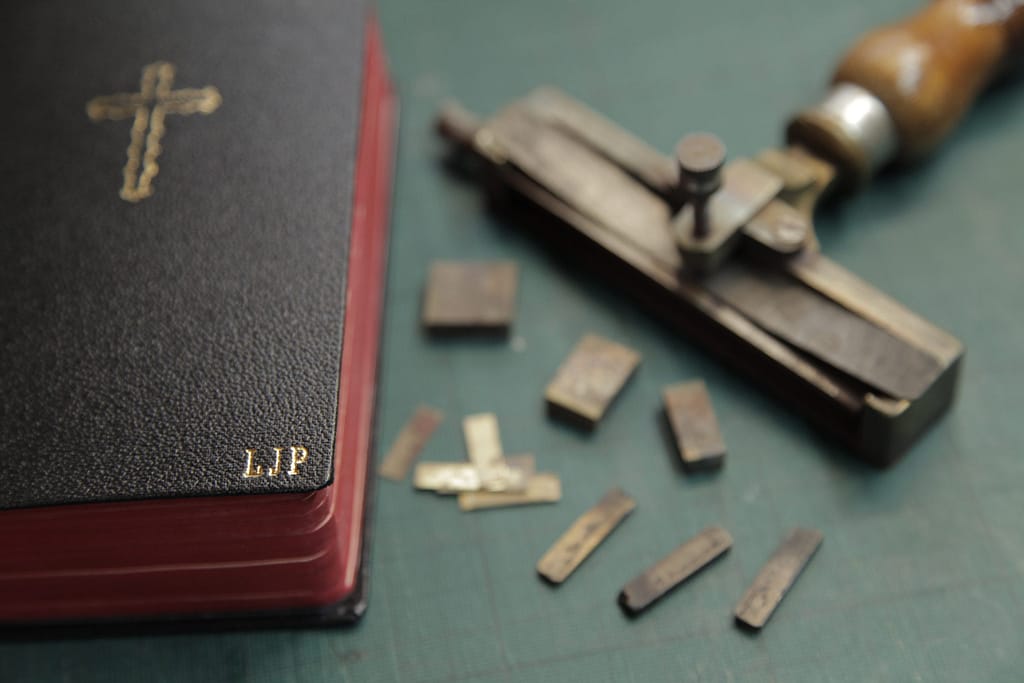Re-casing and re-colouring an important Counter-Reformation publication
Welcome back to On The Bench, where I show you the traditional bookbinding and book repair work I’m engaged in. At the minute, I’m working on a wide variety of projects, from resewing a dismantled book on to tapes, to making boxes for some stunning vintage volumes of history, hagiography, and poetry – more on those another time, I think!
For this post, however, we’ll be looking at something much humbler – a simple binding of a Douay Rheims Holy Bible. This hand-missal-sized book belongs to a convert was was received into the Church this year (2022). They were keen to have a good, Catholic translation of the Scriptures for their spiritual reading, and their research lead them to this second hand copy, which is in pretty good condition, but starting to show its age.
The reason they went for the Douay Rheims translation was, in part, its history. During the first throws of the Reformation in England, Douai (in Flanders) was the centre of English Catholicism ‘in exile’. The seminary there was established by William Cardinal Allen (a pivotal figure of English Catholic history who really should be better known) for training priests to be smuggled back into England to say clandestine Masses and secretly minister to the faithful. As part of its Counter Reformation mission, a new English translation of the Bible was begun, with the New Testament published in 1582, and the Old Testament following in 1609. This means the whole thing was complete a full two years before the more famous King James Version was published!
There’s a surprisingly in-depth article about this on Wikipedia, of all places! Follow the link to learn more about how the DRV influenced the translators of the KJV, and the earlier influences on the work at Douai and Reims. Somewhat ironically, the book ‘on the bench’ isn’t the actual Douay Rheims translation, but rather the 18th Century update by Bishop Richard Challoner (another figure who should be better known). He was conscious that some of the language used in the original was nigh-on unreadable, and sought to render a fluid translation so English Catholics would have an easier time of it. In fact, the vast majority of ‘Douay Rheims’ versions since then have, in truth, been Challoner’s. This edition makes only passing reference to Challoner and his ‘notes’, while making a big deal about the connection to the original OT and NT publications, on the title page. Rather cheekily, in my view!
There are only two noteworthy ‘Peculiars’ in this book, one being the standard inscription in the front – ‘To Maureen 8/1/52’. The other is a memorial card for a priest, Mgr. Egan who served at St. Mary’s, Swinton from 1953-1987. This may only be of interest to me, but Swinton is just up the road from where I live, but the current owner doesn’t live near there! The coincidence of the proximity of the dates (book given in ’52, priest arrives in ’53) leads me to assume that Maureen inserted this prayer card into her Bible.
At first the client thought this was a leather-bound bible, but upon closer inspection I discovered it’s covered in ‘leather cloth’ i.e. a textured bookcloth with a leather-like grain. After many decades of (no doubt) pious and contemplative reading , the spine cover has split along the hinge, and the gilded title has worn off completely. Likewise, the red page-edges have dulled to a dirty pink, and the cross on the cover is simply two intersecting lines. Structurely, though, the textblock is sound, and so a nice new cover (or ‘case’, more properly speaking) will really freshen up the look of this old bible.
Once I’d disassembled the book, I began by renewing the colouring on the textblock edges. I clamped the textblock in the finishing press, and sanded down each edge in turn with progressively finer abrasive paper until it was almost shiny smooth. Applying the red acrylic ink to the paper is best done in one smooth motion, and I built up layers of it rather than trying to apply it all in one go. After only a few coats, the deep rich red colour was back, just as it would have been when Maureen first had this Bible back in the 1950s.
I won’t go into any detail about the work I did on the textblock spine, since I described all of that in my post on the St. Andrew’s Daily Missal. After a quick paper repair to the only torn page in the Bible, I was ready to move on to the most striking part of this book restoration project – the new case.
I used black leathercloth, in keeping with the original. That’s where the similarities between the two bindings end. The original was decidedly plain, so I proposed adding a few more touches of gold to really enhance the style, and the owner was more than happy with my ideas. I added ‘Douay Rheims’ in gold to the spine, since the edition was important to the customer – I think most people, seeing a Bible like this, would assume it was the King James Version!
To replace the rather dull cross which graced the old cover, I used an antique brass tool to add a floreated cross in gold. Even with the card template I made to help with placement, it still required a lot of concentration, as you can see!
For the final little touch, I added the owner’s initials to the front cover in gold. Surely having these personal flourishes is one of the main benefits of having a bookbinder work on your books! Setting brass type by hand can certainly be tedious work, especially filling up the type holder with ‘quads and spacers’, the plain blocks and slivers of brass which sandwich the letters in place.
In the end, though, it was all worth it. Take a look at the gallery below, and let me know if you agree! Do you know anyone who shares our love of Catholic books and culture? Please do share this post with them, and if you’ve got any questions, leave a comment below and I’ll be delighted to chat.















WOW….Where have you been hiding Mark.
This dying craftsmanship is such a huge welcome.
Thank you for your dedication to old books.
You will be truly blessed.
Margaret R……
Thanks Margaret, that’s very kind of you! How did you stumble across my humble blog? There are more posts on the way, I promise.